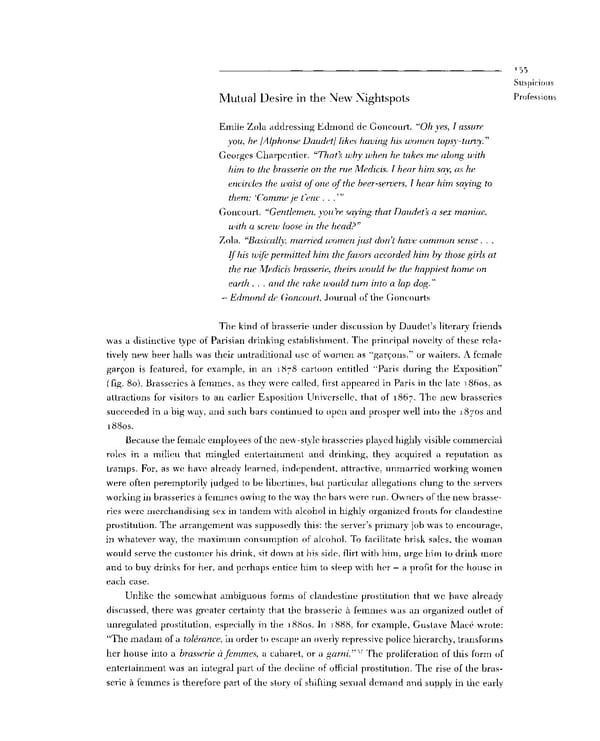*33 Suspicious Mutual Desire in the New Nightspots Professions Emile Zola addressing Edmond de Goncourt. "Oh yes, I assure you, he [Alphonse Daudet] likes having his women topsy-turvy." Georges Charpentier. "That's why when he takes me along with him to the brasserie on the rue Medicis, I hear him say, as he encircles the waist of one of the beer-servers, I hear him saying to them: 'Comme je t'enc . . .'" Goncourt. "Gentlemen, you're saying that Daudet's a sex maniac, with a screw loose in the head?" Zola. "Basically, married women just don t have common sense . . . If his wife permitted him the favors accorded him by those girls at the rue Medicis brasserie, theirs would be the happiest home on earth . . . and the rake would turn into a lap dog." - Edmond de Goncourt, Journal of the Goncourts The kind of brasserie under discussion by Daudet's literary friends was a distinctive type of Parisian drinking establishment. The principal novelty of these rela- tively new beer halls was their untraditional use of women as "gargons," or waiters. A female gargon is featured, for example, in an 1878 cartoon entitled "Paris during the Exposition" (fig. 80). Brasseries a femmes, as they were called, first appeared in Paris in the late i86os, as attractions for visitors to an earlier Exposition Universelle, that of 1867. The new brasseries succeeded in a big way, and such bars continued to open and prosper well into the 18708 and i88os. Because the female employees of the new-style brasseries played highly visible commercial roles in a milieu that mingled entertainment and drinking, they acquired a reputation as tramps. For, as we have already learned, independent, attractive, unmarried working women were often peremptorily judged to be libertines, but particular allegations clung to the servers working in brasseries a femmes owing to the way the bars were run. Owners of the new brasse- ries were merchandising sex in tandem with alcohol in highly organized fronts for clandestine prostitution. The arrangement was supposedly this: the server's primary job was to encourage, in whatever way, the maximum consumption of alcohol. To facilitate brisk sales, the woman would serve the customer his drink, sit down at his side, flirt with him, urge him to drink more and to buy drinks for her, and perhaps entice him to sleep with her — a profit for the house in each case. Unlike the somewhat ambiguous forms of clandestine prostitution that we have already discussed, there was greater certainty that the brasserie a femmes was an organized outlet of unregulated prostitution, especially in the i88os. In 1888, for example, Gustave Mace wrote: "The madam of a tolerance, in order to escape an overly repressive police hierarchy, transforms 57 her house into a brasserie a femmes, a cabaret, or a garni. " The proliferation of this form of entertainment was an integral part of the decline of official prostitution. The rise of the bras- serie a femmes is therefore part of the story of shifting sexual demand and supply in the early
 Prostitution & Impressionists Page 153 Page 155
Prostitution & Impressionists Page 153 Page 155